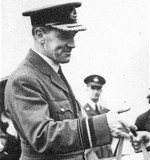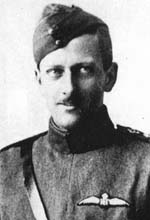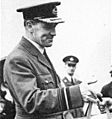Quintin Brand facts for kids
Quick facts for kids
Sir Quintin Brand
|
|
|---|---|

AVM Brand visiting an air base c. 1941
|
|
| Nickname(s) | "Flossie" |
| Born | 25 May 1893 Beaconsfield, Cape Colony |
| Died | 7 March 1968 (aged 74) Umtali, Rhodesia |
| Allegiance | South Africa United Kingdom |
| Service/ |
Union Defence Force Royal Air Force |
| Years of service | 1913–1943 |
| Rank | Air Vice-Marshal |
| Commands held | No. 20 Group (1941–43) No. 10 Group (1940–41) No. 56 Squadron (1923–25) No. 44 Squadron (1919) No. 151 Squadron (1918–19) No. 112 Squadron (1918) |
| Battles/wars | First World War Second World War |
| Awards | Knight Commander of the Order of the British Empire Distinguished Service Order Military Cross Distinguished Flying Cross Order of Ismail (Egypt) |
Air Vice-Marshal Sir Christopher Joseph Quintin Brand (born May 25, 1893 – died March 7, 1968) was a brave South African officer who became a top leader in the Royal Air Force (RAF). He was known for his amazing flying skills and courage during both the First World War and the Second World War.
Contents
Early Life and Joining the Military
Quintin Brand was born in Beaconsfield, a town in South Africa that is now part of Kimberley, Northern Cape. His father was a police inspector. In 1913, when he was 20 years old, Quintin joined the South African Defence Force.
Flying High in the First World War
In 1915, Quintin Brand moved to England. There, he joined the Royal Flying Corps, which was the air force before it became the RAF. He quickly learned to fly and earned his pilot's license in March 1916.
During the First World War, he flew fast Nieuport 17 fighter planes. He served in France as a flight commander, leading groups of planes. Later, he returned to England.
In 1918, Brand became the commander of No. 112 Squadron RAF. This squadron was special because it flew night fighter planes, like modified Sopwith Camels, to protect England from enemy air raids at night. He even shot down a German Gotha bomber over England in May 1918.
After that, he led No. 151 Squadron RAF in France. This squadron also focused on fighting German planes at night. Under his command, the squadron shot down 26 German aircraft. Quintin Brand himself shot down four planes, making him the most successful RAF night fighter pilot of the First World War. He was awarded the Distinguished Flying Cross for his bravery.
A Daring Flight to South Africa
After the war, in 1920, a newspaper called The Times offered a huge prize of £10,000. This prize was for the first pilot to fly all the way from London, England, to Cape Town, South Africa.
The South African leader, General Smuts, wanted South African pilots to achieve this amazing feat. So, a Vickers Vimy plane was bought for the journey. It was named Silver Queen. Quintin Brand was chosen as the co-pilot, flying alongside Lieutenant Colonel Pierre van Ryneveld.
Their journey began on February 4, 1920. They faced many challenges. Their first plane, Silver Queen, had engine trouble and had to land early. The RAF loaned them a second plane, which they named Silver Queen II. This plane also crashed when taking off in Southern Rhodesia. But Quintin Brand and van Ryneveld didn't give up! They borrowed a smaller plane, an Airco DH.9, to finish the journey to Cape Town.
Even though they didn't win the prize because they used different planes, the South African government gave them £5,000 each for their incredible effort. Both Quintin Brand and van Ryneveld were also made knights for their historic flight.
After this famous flight, Brand continued his career in aviation. He worked at the Royal Aircraft Establishment in England, helping to improve airplanes. From 1932 to 1936, he was the Director-General of Aviation in Egypt.
Leading in the Second World War
When the Second World War began, Quintin Brand played a very important role. He became the air officer commanding No. 10 (Fighter) Group. This group was in charge of defending southwest England and South Wales from German air attacks.
During the Battle of Britain, a huge air battle, Brand strongly believed in using small, fast groups of fighter planes to stop the German Luftwaffe bombers. His leadership helped protect southwest England and also supported other RAF groups that were fighting in other parts of the country.
Later, he led No. 20 (Training) Group, which trained new pilots. He retired from the RAF on November 6, 1943, with the high rank of air vice-marshal.
Later Years
After retiring from the military, Quintin Brand married Mildred Vaughan in 1943. They lived in England until 1950, when they moved to Southern Rhodesia (now Zimbabwe). Sir Quintin Brand passed away on March 7, 1968.
Honours and Awards
Sir Quintin Brand received many awards for his bravery and service:
- Military Cross (1917): He received this for his outstanding courage during patrols. He once attacked five enemy planes with only one other plane and shot one down.
- Distinguished Service Order (1918): This award was given for his amazing bravery during a night air raid. He attacked an enemy plane at night, and even though the flames from the crashing enemy plane scorched his face, he kept fighting.
- Knight Commander of the Order of the British Empire (1920): He was knighted for his valuable part in the successful flight from England to Cape Town, South Africa.
Images for kids






